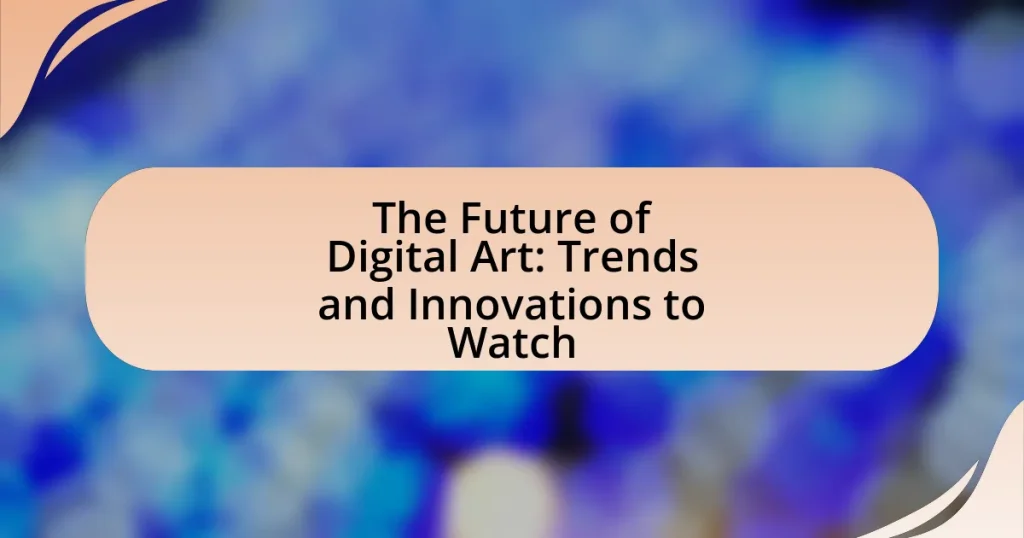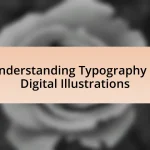The article “The Future of Digital Art: Trends and Innovations to Watch” explores the evolving landscape of digital art, highlighting key trends such as generative art, augmented reality (AR), virtual reality (VR), and blockchain technology. It examines how these advancements are reshaping artistic creation, ownership, and market dynamics, particularly through the rise of non-fungible tokens (NFTs). Additionally, the article discusses the influence of artificial intelligence and machine learning on art production, the role of social media in enhancing visibility, and the impact of cloud technology on collaboration among artists. It concludes by addressing the skills and strategies necessary for artists to thrive in this rapidly changing environment.
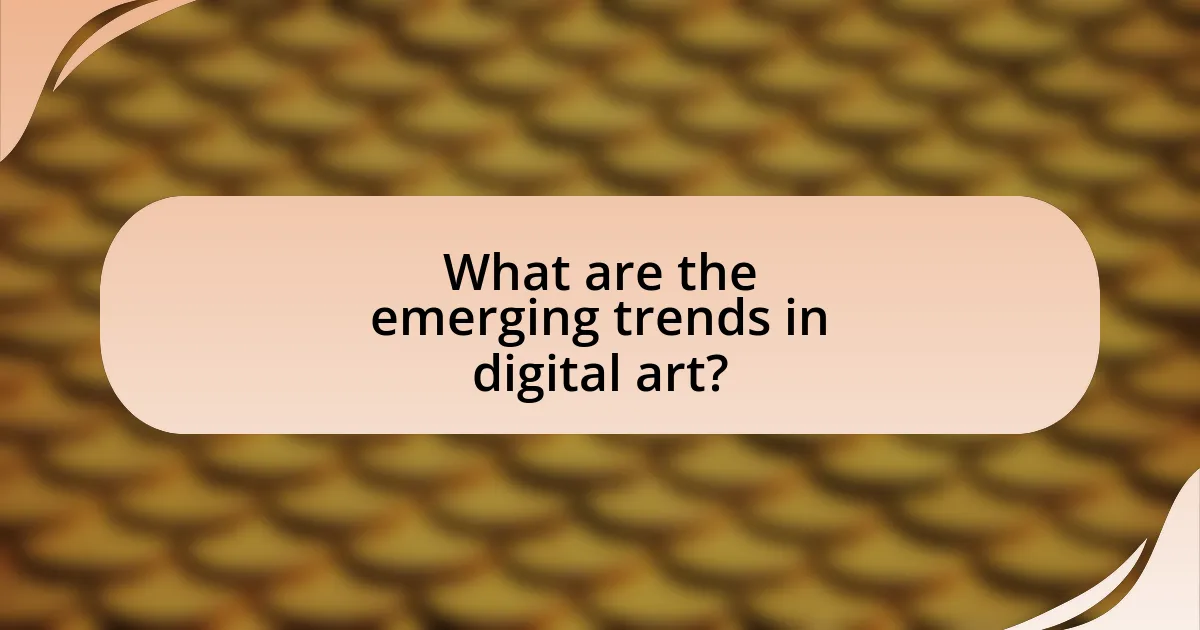
What are the emerging trends in digital art?
Emerging trends in digital art include the rise of generative art, the integration of augmented reality (AR) and virtual reality (VR), and the increasing use of blockchain technology for digital ownership. Generative art, created through algorithms and code, has gained popularity as artists explore new creative possibilities. AR and VR are transforming how audiences experience art, allowing for immersive environments that enhance engagement. Additionally, blockchain technology is facilitating the creation and sale of non-fungible tokens (NFTs), providing artists with new revenue streams and ensuring provenance. These trends reflect the evolving landscape of digital art, driven by technological advancements and changing consumer preferences.
How is technology influencing the evolution of digital art?
Technology is significantly influencing the evolution of digital art by providing new tools and platforms that enhance creativity and accessibility. The advent of software like Adobe Creative Suite and open-source alternatives has democratized art creation, allowing artists of all skill levels to produce high-quality work. Additionally, advancements in artificial intelligence, such as generative art algorithms, enable artists to explore innovative styles and techniques that were previously unattainable. The rise of blockchain technology and NFTs has transformed the way digital art is bought, sold, and owned, creating new economic models for artists. According to a report by Art Basel and UBS, the global market for NFTs reached $2.6 billion in the first quarter of 2021 alone, highlighting the financial impact of technology on digital art.
What role do artificial intelligence and machine learning play in digital art creation?
Artificial intelligence and machine learning significantly enhance digital art creation by automating processes, generating unique artworks, and providing tools for artists to explore new creative avenues. These technologies enable algorithms to analyze vast datasets of existing art, learning styles and techniques, which can then be applied to create original pieces or assist artists in their work. For instance, AI models like DeepArt and DALL-E utilize neural networks to transform images or generate art based on textual descriptions, showcasing the capability of machine learning to innovate within the artistic domain. The integration of AI and machine learning in digital art not only streamlines workflows but also expands the possibilities for artistic expression, making it a transformative force in the future of art.
How are virtual and augmented reality shaping the digital art landscape?
Virtual and augmented reality are transforming the digital art landscape by enabling immersive experiences and interactive engagement. Artists can create three-dimensional environments that allow viewers to explore and interact with art in ways that traditional mediums cannot offer. For instance, platforms like Oculus Medium and Tilt Brush allow artists to paint and sculpt in a virtual space, enhancing creativity and expression. Additionally, augmented reality applications, such as Artivive, enable artists to overlay digital content onto physical artworks, creating a hybrid experience that merges the real and digital worlds. This shift is supported by the growing adoption of VR and AR technologies, with the global AR and VR market projected to reach $209.2 billion by 2022, indicating a significant impact on how art is created, experienced, and consumed.
What are the key styles and movements in contemporary digital art?
Key styles and movements in contemporary digital art include generative art, glitch art, and virtual reality art. Generative art utilizes algorithms and computer code to create unique artworks, exemplified by artists like Casey Reas, co-founder of Processing, who emphasizes the role of the artist as a programmer. Glitch art embraces digital errors and distortions, transforming them into aesthetic expressions, as seen in the works of artists like Rosa Menkman, who explores the beauty of digital decay. Virtual reality art immerses viewers in interactive environments, with creators like Jon Rafman pushing the boundaries of narrative and experience in digital spaces. These movements reflect the evolving relationship between technology and artistic expression, showcasing how digital tools redefine creativity in the contemporary art landscape.
How do generative art and algorithmic design fit into the digital art scene?
Generative art and algorithmic design are integral to the digital art scene as they leverage computational processes to create unique artworks. These forms of art utilize algorithms to generate visuals, often resulting in pieces that are unpredictable and complex, reflecting the capabilities of modern technology. For instance, artists like Casey Reas and Joshua Davis have pioneered this field, demonstrating how code can be a medium for artistic expression. The rise of platforms such as Art Blocks has further popularized generative art, allowing artists to sell algorithmically generated pieces as NFTs, thus merging technology with the art market. This intersection of art and technology not only expands the definition of creativity but also challenges traditional notions of authorship and originality in art.
What is the significance of NFT (Non-Fungible Tokens) in the digital art market?
NFTs (Non-Fungible Tokens) are significant in the digital art market as they provide a mechanism for artists to authenticate and monetize their work in a decentralized manner. By using blockchain technology, NFTs ensure that each digital artwork is unique and verifiable, allowing artists to establish ownership and provenance. This has led to a surge in sales, with the NFT art market generating over $2.5 billion in sales in the first quarter of 2021 alone, according to a report by NonFungible.com. Additionally, NFTs enable artists to receive royalties on secondary sales, creating ongoing revenue streams that traditional art markets do not offer.
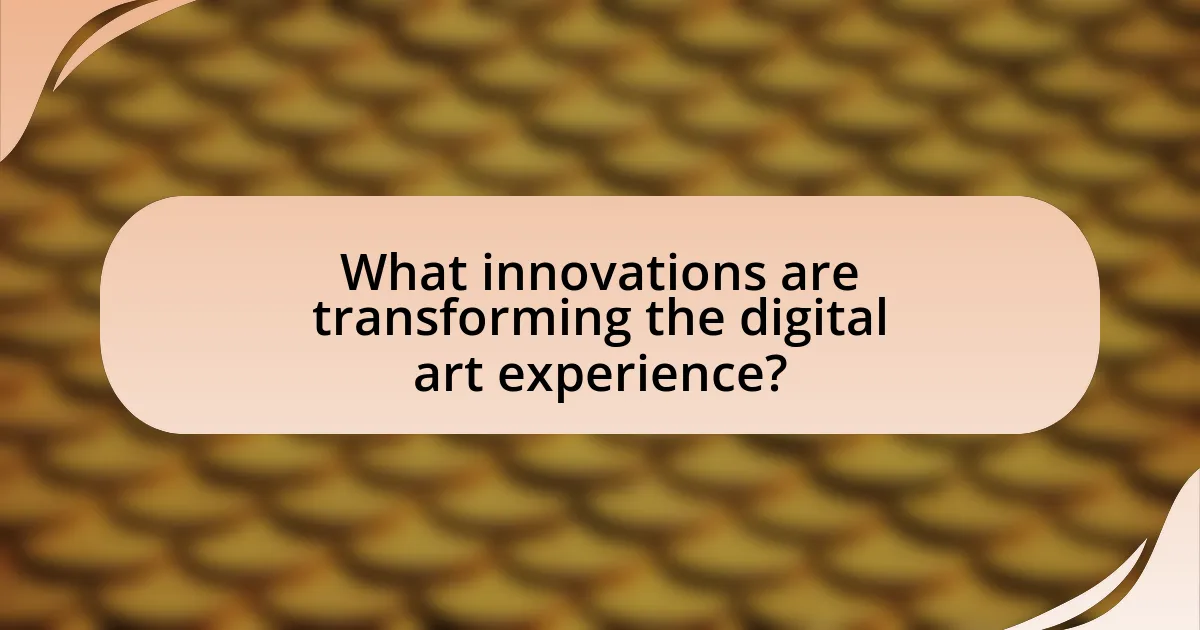
What innovations are transforming the digital art experience?
Innovations transforming the digital art experience include augmented reality (AR), virtual reality (VR), and blockchain technology. AR enhances the viewing experience by allowing users to interact with digital art in real-world environments, while VR immerses users in fully digital worlds, creating a more engaging experience. Blockchain technology enables artists to tokenize their work, ensuring provenance and ownership through non-fungible tokens (NFTs), which have revolutionized how art is bought and sold. According to a report by Art Basel and UBS, the NFT market reached $2.6 billion in sales in the first quarter of 2021 alone, highlighting the significant impact of these innovations on the art market.
How are new tools and software changing the way artists create digital art?
New tools and software are revolutionizing the way artists create digital art by enhancing accessibility, improving efficiency, and expanding creative possibilities. For instance, software like Procreate and Adobe Fresco allows artists to work on mobile devices, making digital art more accessible to a wider audience. Additionally, advancements in artificial intelligence, such as Adobe’s Sensei, automate repetitive tasks, enabling artists to focus more on creativity rather than technical execution. Furthermore, tools like 3D modeling software and virtual reality platforms provide artists with innovative ways to visualize and interact with their work, pushing the boundaries of traditional art forms. These developments reflect a significant shift in the digital art landscape, allowing for greater experimentation and collaboration among artists.
What are the most popular digital art platforms and applications currently available?
The most popular digital art platforms and applications currently available include Procreate, Adobe Photoshop, Corel Painter, Clip Studio Paint, and ArtRage. Procreate is widely favored for its intuitive interface and powerful features, making it a top choice among digital artists, particularly on iPad. Adobe Photoshop remains a staple in the industry due to its extensive capabilities for photo editing and digital painting. Corel Painter is known for its realistic brush simulation, appealing to traditional artists transitioning to digital. Clip Studio Paint is popular for comic and manga creation, offering specialized tools for artists in that niche. ArtRage provides a unique experience with its focus on traditional painting techniques in a digital format. These platforms are frequently updated and supported by large user communities, enhancing their popularity and usability.
How does cloud technology enhance collaboration among digital artists?
Cloud technology enhances collaboration among digital artists by providing real-time access to shared resources and tools, enabling seamless communication and project management. This technology allows multiple artists to work on the same project simultaneously from different locations, facilitating instant feedback and iterative design processes. For instance, platforms like Adobe Creative Cloud and Google Drive enable artists to share files, edit collaboratively, and maintain version control, which streamlines workflows and reduces the time spent on revisions. According to a report by Statista, 67% of organizations using cloud services reported improved collaboration among teams, highlighting the effectiveness of cloud technology in fostering teamwork among digital artists.
What impact do social media and online communities have on digital art visibility?
Social media and online communities significantly enhance digital art visibility by providing platforms for artists to showcase their work to a global audience. These platforms, such as Instagram, Twitter, and specialized art communities like DeviantArt, allow artists to share their creations instantly, reaching millions of potential viewers and buyers. According to a 2021 survey by Artfinder, 70% of artists reported that social media was their primary tool for gaining visibility and connecting with audiences. This widespread use of social media not only democratizes access to art but also fosters engagement through likes, shares, and comments, which can lead to increased recognition and opportunities for collaboration.
How can artists leverage social media to promote their digital art effectively?
Artists can leverage social media to promote their digital art effectively by utilizing platforms like Instagram, Twitter, and TikTok to showcase their work, engage with audiences, and build a personal brand. By posting high-quality images and videos of their art, artists can attract followers and potential buyers, as visual content is highly shareable and can reach a wider audience. According to a 2021 survey by Hootsuite, 54% of social media users use these platforms to research products, indicating that a strong online presence can directly influence purchasing decisions. Additionally, artists can use hashtags strategically to increase visibility and participate in art challenges or collaborations to expand their reach. Engaging with followers through comments and direct messages fosters community and loyalty, which can lead to increased sales and opportunities.
What are the challenges and opportunities presented by online art marketplaces?
Online art marketplaces face challenges such as market saturation and issues with authenticity, while also presenting opportunities for broader audience reach and lower entry barriers for artists. The proliferation of platforms has led to increased competition, making it difficult for individual artists to stand out. Additionally, concerns about the verification of artwork authenticity can undermine buyer confidence. Conversely, these marketplaces enable artists to connect with global audiences, significantly expanding their potential customer base. According to a report by Art Basel and UBS, online sales in the art market reached $12.4 billion in 2021, highlighting the growing acceptance and opportunity within this digital space.
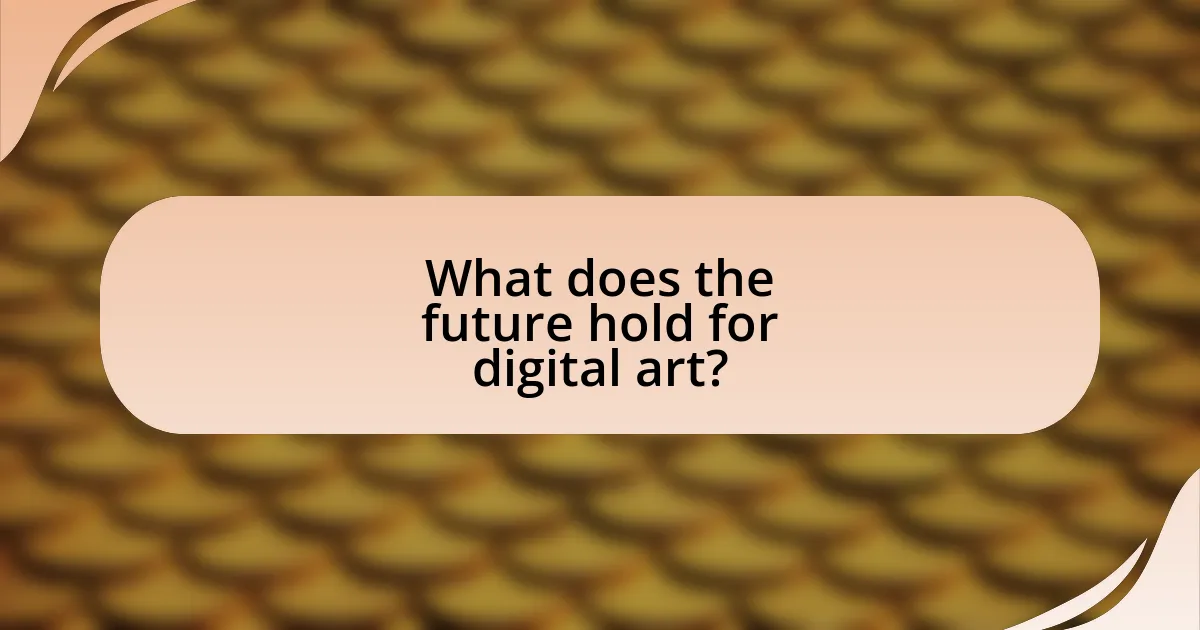
What does the future hold for digital art?
The future of digital art is poised for significant growth and innovation, driven by advancements in technology and changing consumer preferences. Emerging technologies such as artificial intelligence, augmented reality, and blockchain are reshaping how digital art is created, distributed, and monetized. For instance, AI-generated art is gaining traction, with platforms like DALL-E and Midjourney enabling artists to explore new creative possibilities. Additionally, the rise of NFTs (non-fungible tokens) has transformed the art market, allowing artists to sell their work directly to collectors while ensuring provenance and ownership. According to a report by Art Basel and UBS, the global art market reached $65.1 billion in 2021, with digital art sales significantly contributing to this growth. This trend indicates that digital art will continue to evolve, becoming more integrated into mainstream culture and commerce.
How will the integration of blockchain technology affect digital art ownership?
The integration of blockchain technology will fundamentally transform digital art ownership by providing verifiable proof of authenticity and provenance. Blockchain’s decentralized ledger allows artists to create unique digital assets, known as non-fungible tokens (NFTs), which can be bought, sold, and traded while ensuring that ownership records are immutable and transparent. This technology addresses issues of copyright infringement and forgery, as each transaction is securely recorded on the blockchain, making it easy to trace the history of ownership. According to a report by NonFungible.com, the NFT market reached a valuation of $10.7 billion in 2021, highlighting the growing significance of blockchain in establishing ownership rights in the digital art space.
What are the potential implications of digital art on traditional art markets?
Digital art has the potential to significantly disrupt traditional art markets by democratizing access to art and altering valuation mechanisms. The rise of platforms for digital art sales, such as NFTs (non-fungible tokens), allows artists to reach global audiences directly, bypassing traditional galleries and auction houses. This shift can lead to a decrease in the exclusivity and perceived value of traditional artworks, as digital art can be reproduced and distributed widely without loss of quality. Furthermore, the integration of blockchain technology in digital art sales provides transparent provenance, which can challenge the established methods of authenticity verification in traditional art markets. As a result, traditional art institutions may need to adapt their business models and embrace digital innovations to remain relevant in an evolving landscape.
How might the role of the artist evolve in the digital age?
The role of the artist in the digital age is likely to evolve towards greater collaboration with technology and increased accessibility to audiences. As digital tools become more sophisticated, artists will integrate artificial intelligence, virtual reality, and augmented reality into their creative processes, allowing for innovative forms of expression and interaction. For instance, a study by the National Endowment for the Arts in 2020 highlighted that 53% of artists reported using digital platforms to reach wider audiences, indicating a shift in how art is disseminated and experienced. This evolution will also empower artists to engage in interdisciplinary projects, merging art with science and technology, thus redefining traditional boundaries and expanding the definition of art itself.
What skills will future digital artists need to thrive?
Future digital artists will need a combination of technical skills, creativity, and adaptability to thrive. Proficiency in software such as Adobe Creative Suite, Blender, and Procreate is essential, as these tools are industry standards for creating digital art. Additionally, understanding emerging technologies like virtual reality (VR), augmented reality (AR), and artificial intelligence (AI) will be crucial, as these technologies are increasingly integrated into digital art practices.
Moreover, strong storytelling abilities and a keen sense of design principles will enhance their work, allowing artists to create engaging and meaningful content. The ability to adapt to new trends and continuously learn will also be vital, as the digital art landscape is rapidly evolving. According to a report by the World Economic Forum, creativity and technological proficiency are among the top skills needed in the future job market, underscoring the importance of these competencies for digital artists.
How can aspiring digital artists prepare for the changing landscape of the industry?
Aspiring digital artists can prepare for the changing landscape of the industry by continuously updating their skills and embracing new technologies. This includes learning software tools like Adobe Creative Suite, Blender, and emerging platforms such as virtual reality (VR) and augmented reality (AR) applications. According to a report by the International Data Corporation, the global AR and VR market is expected to grow to $209.2 billion by 2022, indicating a significant shift towards immersive experiences in digital art. Additionally, artists should engage with online communities and platforms to showcase their work, receive feedback, and stay informed about industry trends. Networking with other professionals and participating in workshops can also enhance their adaptability to evolving market demands.
What are the best practices for staying relevant in the digital art world?
To stay relevant in the digital art world, artists should continuously update their skills and engage with current trends. This involves regularly learning new software and techniques, as the digital landscape evolves rapidly, with tools like Adobe Creative Cloud and Procreate frequently updating their features. Additionally, participating in online communities and social media platforms, such as Instagram and Behance, allows artists to showcase their work, receive feedback, and connect with other creatives, which is essential for visibility and networking. According to a survey by Artfinder, 70% of artists reported that social media significantly impacted their career growth, highlighting its importance in maintaining relevance.
What practical tips can enhance the digital art creation process?
To enhance the digital art creation process, artists should utilize high-quality hardware and software, as these tools significantly impact the efficiency and quality of the artwork. Investing in a powerful graphics tablet and software like Adobe Photoshop or Procreate allows for greater precision and flexibility in creating art. Additionally, maintaining an organized workspace and using layers effectively can streamline the workflow, making it easier to manage complex projects. Research indicates that artists who adopt structured workflows and utilize advanced tools produce higher-quality work more efficiently, as seen in studies on creative productivity.
How can artists effectively utilize feedback from online communities?
Artists can effectively utilize feedback from online communities by actively engaging with their audience, analyzing the feedback received, and implementing constructive suggestions into their work. Engaging with the audience fosters a sense of community and encourages open dialogue, which can lead to valuable insights about artistic direction and preferences. Analyzing feedback allows artists to identify common themes or critiques, helping them understand what resonates with their audience. Implementing constructive suggestions can enhance the quality of their art and align it more closely with audience expectations, ultimately leading to increased visibility and support. Research indicates that artists who adapt their work based on audience feedback often experience greater success in digital platforms, as they create content that is more relevant and appealing to their followers.
What strategies can help digital artists maintain creativity and inspiration?
Digital artists can maintain creativity and inspiration by regularly engaging in diverse artistic practices, collaborating with other artists, and setting aside dedicated time for experimentation. Engaging in diverse practices, such as exploring different mediums or styles, can stimulate new ideas and perspectives. Collaboration with other artists fosters a creative exchange that can lead to innovative concepts and techniques. Additionally, dedicating specific time for experimentation allows artists to explore without the pressure of producing finished work, which can lead to unexpected breakthroughs. Research indicates that varied experiences and collaborative environments significantly enhance creative output, as shown in studies by the American Psychological Association, which highlight the benefits of diverse interactions in fostering creativity.
